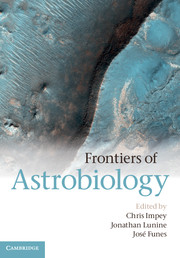Book contents
- Frontmatter
- Contents
- List of contributors
- Part I Introduction
- Part II Origin of Planets and Life
- Part III History of Life on Earth
- Part IV Habitability of the Solar System
- 8 Early Mars – Cradle or Cauldron?
- 9 Large Habitable Moons
- 10 Small Habitable Worlds
- Part V Exoplanets and Life in the Galaxy
- Index
- Plate Section
- References
9 - Large Habitable Moons
Titan and Europa
from Part IV - Habitability of the Solar System
Published online by Cambridge University Press: 05 December 2012
- Frontmatter
- Contents
- List of contributors
- Part I Introduction
- Part II Origin of Planets and Life
- Part III History of Life on Earth
- Part IV Habitability of the Solar System
- 8 Early Mars – Cradle or Cauldron?
- 9 Large Habitable Moons
- 10 Small Habitable Worlds
- Part V Exoplanets and Life in the Galaxy
- Index
- Plate Section
- References
Summary
Introduction
The “classical” criteria for habitability can be summarized as the presence of liquid water, energy sources to sustain metabolism, and “nutrients” over a period of time long enough to allow the development of life. The concept of a “habitable zone” (HZ) around each star defines where water can be stable at the surface as a result of the equilibrium temperature of the planet in the star's radiation field. Liquid water may exist on the surface of planets orbiting a star at a distance that does not induce tidal lock. But habitability conditions can be found not only on the surfaces of Earth-like planets: a subsurface ocean within a planet or the satellite of a gas giant may be habitable for some life form that may be very different from Earth-like life. Indeed, icy surfaces may cover liquid oceans, move and fracture like plate tectonics, and exsolute the internal material and energy through an interconnected system. With the discovery of planets beyond the Solar System and the search for life in exotic habitats such as Mars, Europa, Titan, and Enceladus, habitability in general needs a better and broader definition.
Liquid water has been recognized as the best solvent for life to emerge and evolve, although other possibilities have been suggested (e.g. Bains 2004). Water, an abundant compound in our galaxy (e.g. Cernicharo and Crovisier 2005), is liquid within a large range of temperatures and pressures and is also a strong polar–nonpolar solvent. This dichotomy is essential for maintaining stable biomolecular and cellular structures (Des Marais et al. 2002). A large number of organisms is capable of living in water. However, in a body of pure water, life will probably never spontaneously originate and evolve. This is because, while there are many organisms living in water, none we know of is capable of living on water alone because life requires other essential elements such as nitrogen and phosphorus in addition to hydrogen and oxygen. Besides, no organism we know of is made entirely of water. So obviously “just water” is not an auspicious place for starting life and evolution in.
- Type
- Chapter
- Information
- Frontiers of Astrobiology , pp. 175 - 200Publisher: Cambridge University PressPrint publication year: 2012
References
- 3
- Cited by



